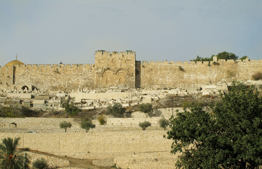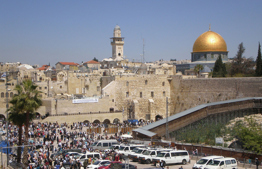Parashat Va'era: The Fifth Term of Redemption

A look at the fifth term of redemption: "heveiti," that Hashem will bring us to the Land of Israel. So why don't we drink a fifth cup? Also: a survey of Ashkelon, and what do the laws of bills of divorce have to do with the borders of Israel?
"I will bring you into the land which I swore to give to Avraham, Isaac, and Jacob, and I will give it to you for a possession, I the L-rd" (Shemot 6:8).
What about the fifth term?
This verse follows four verses that include the four terms of redemption: hotzeiti, hitzalti, ga'alti, and lakachti; "I will take out," "I will save," "I will redeem," and "I will take." Our verse includes what seems to be the fifth term: "heveiti" "I will bring," the ultimate goal of the entire process of redemption: to bring the Jewish People to the Land of Israel. In light of this, it seems strange that when our Sages instituted the mitzvah of drinking cups of wine as one of the mitzvot at Seder night, they only require four cups, basing this—among other things—on the first four terms of redemption.
The fifth cup is mentioned in certain versions of the Talmud in a Beraita quoting Rabbi Tarfon, who holds that one should drink the fifth cup after the second recitation of the hallel (halel hagadol). The poskim disagree as the status of drinking a fifth cup: some hold that we should not drink the fifth cup at all, since we may not add to the four cups instituted by the Sages (Rashi, Rashbam, Ba'al HaMaor). Others hold that if one wants to drink more wine, it is possible to drink this cup, but it is not a mitzvah (Mordechai). Yet, others maintain that it is an exemplary mitzvah to drink this fifth cup (as implied by the Rambam).
This begs the question: why is the fifth term discriminated against? Especially since it is the ultimate goal—obviously the intent was not to leave the Jewish People in the desert!
"More than redemption"
The Maharal in Gevurot Hashem (chapter 65) relates to this question; he himself holds that while there is no obligation to drink a fifth cup, it is a mitzvah. He believes that the fifth cup represents the completion of the redemption, and was instituted as a representation of something that is "more than redemption." Here you are probably raising an eyebrow: what could possibly be more than redemption? It seems that such a thing does exist. Don't get disappointed—but the Maharal is referring to parnasa, a livelihood, saying that this is even greater than redemption!
While the Maharal does not directly relate to the fifth term of heveiti, it seems that the principle is one and the same. We are dazzled by the extraordinary—when natural order is interrupted and miracles take place. The exodus from Egypt and the whole period in the desert were exactly that, as the Jewish People experienced miracles right and left. In sharp contrast, upon arrival in the Land of Israel, hardly any outright miracles occurred. While there were several outstanding miraculous events—the splitting of the Jordan, the fall of the walls of Jericho, and the boulders falling from heaven at Ma'ale Beit Horon—as a rule the process was slow and natural. As the Torah promises: "I will drive them out before you little by little …" (Shemot 23:30) (supported by archeological findings). Most of the process involved standard warfare—which included Divine assistance, but no overt miracles. Surprisingly, it is precisely this final stage of the redemption from Egypt, settling the Land of Israel, which is far less spectacular than the stages preceding it.
Furthermore, even if throughout the process of the conquest, miracles were still present, following this period, when the Jewish People were already settled in their land, our presence seemed to be a given. Of course we are here: it's our land, and we lived here for hundreds of years. It takes a special, concerted effort to realize that even this routine is not at all to be taken for granted.
This effort is hard work: to internalize that this good situation that continues to persist is not self-understood, since G-d is sustaining us in His Divine goodness, every day, at every moment. For this reason, it is livelihood and the arrival and settling in the Land of Israel that the Maharal believes this verse is referring to. While at face value, these things might be viewed as normal and taken for granted, they are truly ongoing miracles. It is much easier to remember the miracles of Egypt; it is much more difficult to understand that also ongoing good is a tremendous miracle: "Your miracles and wonders that are with us every day." This view of life is a higher standard than the minimum that is generally expected of people. For this reason, the fifth cup is not compulsory.
Ashkelon: Considered the South
One who brings a get, bill of divorce, from overseas must say, "[This document] was written and signed in my presence." … Rabbi Yehudah says, "From Rekem to the East and Rekem is like the East; from Ashkelon to the South and Ashkelon is like the South; from Acco to the North and Acco is like the North."
… [With regard to] one who brings a bill of divorce within Eretz Yisrael, he need not say, "It was written and signed in my presence." If there are any objectors [to its validity], [its validity] must be upheld by [confirming the signatures of] its signatories. (Mishna Gittin 1:1-3)
What does a get have to do with the boundaries of the Land of Israel?
"Wait!"—you're probably wondering—"This article is supposed to be about the mitzvot tied to the Land of Israel, not about the laws of the Even HaEzer! So why are you bringing it up here?" We can answer this question with another: did the Mishna get confused? What does the laws of divorce, which are not tied to the Land of Israel, have to do with the country's boundaries, which Rabbi Yehuda discusses?
The boundaries of the Land of Israel are important for bills of divorce not because of the Land's sanctity, but rather because during the times of the Mishna, this was where the concentration of the Jewish population was located. The Gemara cites two opinions why a messenger who brings a bill of divorce from overseas needs to state that the document was "written and signed in my presence." Rabba maintains that this is because the Jews who lived abroad were not aware that the obligation to write the bill of divorce had to be specifically for the particular husband and wife (and not as a general document), which is why the messenger must declare witnessing its writing and signing for the specific couple. Rava, in contrast, believes that there is a different issue involved here: since convoys do not come often from overseas to the Land of Israel, if anyone objects to the get there will not be witnesses to testify to the get's validity. This is why we require the messenger make this verbal declaration.
Olei Mitzrayim and Olei Bavel
Rabeinu Tam asks about Rabbi Yehuda's statement that "Ashkelon is like the South"; that is, the laws pertaining to Ashkelon are like those South of the Land of Israel, so it is considered outside the Land of Israel (Gittin 2a, s.v. ve'ashkelon kadarom): How is this possible? Ashkelon, after all, is mentioned in Yehoshua (13,3) as part of the Land of Israel. While it was not conquered during the times of Yehoshua, it was certainly included in the region apportioned to the twelve tribes. The beginning of Shoftim mentions that the tribe of Yehuda conquered Ashkelon (and Gaza) and its environs, so it is definitely part of the Land of Israel!
Rabeinu Tam resolves this issue (based on the Gemara in Chullin) by distinguishing between two basic concepts mentioned in the context of the mitzvot tied to the Land of Israel. While Ashkelon was conquered by the Jews who left Egypt (olei Mitzrayim), it was not conquered a second time by those who left Babylon (olei Bavel) during the Second Temple period. Why does this mater for the laws of divorce? The olei Bavel region was essentially the Jewishly populated area during Second Temple times, which did not change drastically even after the Temple's destruction in the times of the Mishna (although, especially following the Bar Kochba Revolt, the major center of Jewish life relocated from Judea to the Galilee). While even outside of their area, Jewish communities still existed, but these centers were much smaller in quantity; Jews living in the periphery were also not as knowledgeable of Torah. Ashkelon, which was not included in this area, was by this time considered "abroad"—not only in terms of the Land's sanctity, but also for practical halachic matters, such as sending a bill of divorce.
It is interesting to note the clear connection between the metaphysical sanctity present in the soil and the Jewish presence on it, which forms an identity pertinent to laws from such different areas of life: the mitzvot tied to the Land of Israel and the laws of divorce. So much so that the Rambam in Hilchot Terumot (1:7) employs the division delineated in Gittin to define the boundaries of olei Bavel, as they pertain to the mitzvot tied to the Land of Israel. This fits in well with the Rambam's view (which we mentioned in earlier articles) (Hilchot Beit HaBechira 6:16) that the second sanctification of the Land of Israel did not take place through a military conquest, rather through a "stronghold"—that is, through Jewish settlement in the area: "and for this reason, every place held by those who went up from Babylonia and sanctified by Ezra's second sanctification is sacred today, even though the Land was taken from us, and is obligated in tithes and the Sabbatical year, just as we explained in the laws of tithes."
As for Ashkelon itself, similar to Beit She'an, had a unique status (Rambam, Hilchot Terumot 1:5). Even though it is included within the boundaries of olei Mitzrayim, as mentioned above, and it was supposed to be subject to terumot and ma'aserot as a rabbinic injunction – it was exempted from the rabbinic obligation, by Rabbi Yehuda HaNasi.
Ashkelon
Ashkelon is one of Israel's ancient cities, and served as a major city during many periods. During the Canaanite period, its port was the largest in the Land of Israel. The city was conquered by the tribe of Yehuda; however, it seems that its Philistine residents stayed there, and not long after it reverted to its original status as one of the five major Philistine cities. During Second Temple times, it still had no Jewish presence. Even following the conquest of Hasmonean King Alexander Jannaeus (Yannai), it retained its Hellenistic character. This does not mean that there weren't personalities we can learn from who lived there: Dama ben Netina, who exemplified respect for his parents, was a local resident. During the Islamic era, it became a fortress; during the reign of the Fatimid dynasty, a Shiite caliphate centered in Egypt. Ashkelon became a holy site in light of the tradition that the head of Hussein ibn Ali, grandson of Muhammad and one of the progenitors of the Shiite tradition, was buried there in 7th century CE. His burial site is located near Barzilai Hospital, and the ancient mosque that was built on the site was bombed in 5710 (1950) at the directive of Moshe Dayan. Nevertheless, dozens of pilgrims still stream there every year, especially from India and Pakistan.
For a certain time, Ashkelon served as an important Crusader city; to prevent additional Crusader invasions, Mamluk Sultan Baybars demolished the city and sealed off the harbor. Following the destruction of both city and harbor, the city was abandoned. Next to the ruins of Ashkelon, the settlement al Majdal developed, which in the 16th century became the fifth largest city in the Land of Israel (with nearly 3,000 inhabitants). As part of Operation Yoav during the War of Independence, al Majdal was conquered and its Arab residents fled. Those who remained were later relocated to Ramle. In place of al Majdal a settlement was established, initially called Migdal Gad. Later on the name Ashkelon was readopted. It was settled mainly by recent immigrants. Today (2017) Ashkelon is Israel's 13th largest city, with nearly 138,000 residents.




